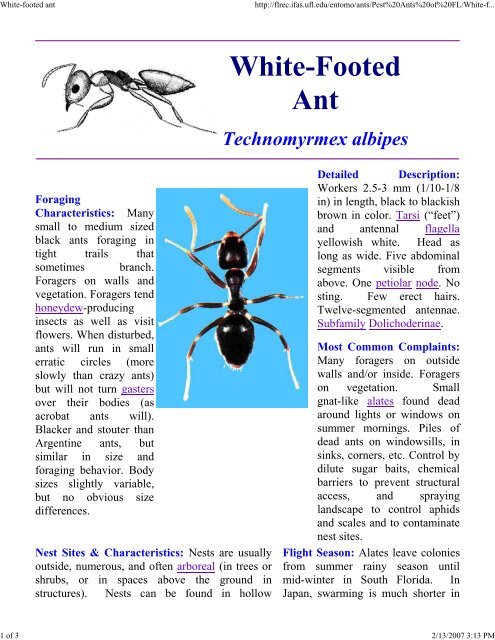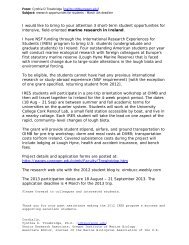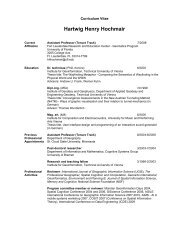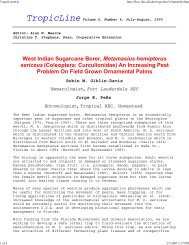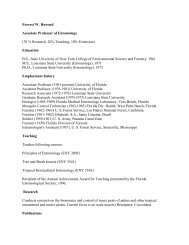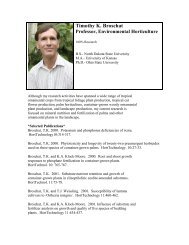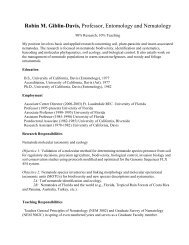White-Footed Ant, Technomyrmex albipes
White-Footed Ant, Technomyrmex albipes
White-Footed Ant, Technomyrmex albipes
Create successful ePaper yourself
Turn your PDF publications into a flip-book with our unique Google optimized e-Paper software.
<strong>White</strong>-footed ant http://flrec.ifas.ufl.edu/entomo/ants/Pest%20<strong>Ant</strong>s%20of%20FL/<strong>White</strong>-f...<br />
Foraging<br />
Characteristics: Many<br />
small to medium sized<br />
black ants foraging in<br />
tight trails that<br />
sometimes branch.<br />
Foragers on walls and<br />
vegetation. Foragers tend<br />
honeydew-producing<br />
insects as well as visit<br />
flowers. When disturbed,<br />
ants will run in small<br />
erratic circles (more<br />
slowly than crazy ants)<br />
but will not turn gasters<br />
over their bodies (as<br />
acrobat ants will).<br />
Blacker and stouter than<br />
Argentine ants, but<br />
similar in size and<br />
foraging behavior. Body<br />
sizes slightly variable,<br />
but no obvious size<br />
differences.<br />
Nest Sites & Characteristics: Nests are usually<br />
outside, numerous, and often arboreal (in trees or<br />
shrubs, or in spaces above the ground in<br />
structures). Nests can be found in hollow<br />
<strong>White</strong>-<strong>Footed</strong><br />
<strong>Ant</strong><br />
<strong>Technomyrmex</strong> <strong>albipes</strong><br />
Detailed Description:<br />
Workers 2.5-3 mm (1/10-1/8<br />
in) in length, black to blackish<br />
brown in color. Tarsi (“feet”)<br />
and antennal flagella<br />
yellowish white. Head as<br />
long as wide. Five abdominal<br />
segments visible from<br />
above. One petiolar node. No<br />
sting. Few erect hairs.<br />
Twelve-segmented antennae.<br />
Subfamily Dolichoderinae.<br />
Most Common Complaints:<br />
Many foragers on outside<br />
walls and/or inside. Foragers<br />
on vegetation. Small<br />
gnat-like alates found dead<br />
around lights or windows on<br />
summer mornings. Piles of<br />
dead ants on windowsills, in<br />
sinks, corners, etc. Control by<br />
dilute sugar baits, chemical<br />
barriers to prevent structural<br />
access, and spraying<br />
landscape to control aphids<br />
and scales and to contaminate<br />
nest sites.<br />
Flight Season: Alates leave colonies<br />
from summer rainy season until<br />
mid-winter in South Florida. In<br />
Japan, swarming is much shorter in<br />
1 of 3 2/13/2007 3:13 PM
<strong>White</strong>-footed ant http://flrec.ifas.ufl.edu/entomo/ants/Pest%20<strong>Ant</strong>s%20of%20FL/<strong>White</strong>-f...<br />
branches, and in any small spaces that might<br />
accommodate a pocket of ants, including under<br />
potted plants, in leaf litter, in the bases of palm<br />
fronds or banana leaves, between cut logs, in yard<br />
toys, in old termite galleries, under bark, behind<br />
hurricane shutter brackets, under fascia boards,<br />
and between bricks. Nests are readily abandoned<br />
and relocated when disturbed. Colonies can have<br />
many hundreds of queens, spread out among many<br />
subcolonies. Wingless reproductives cannot easily<br />
be distinguished from workers. Colony<br />
reproduction is by swarming or budding.<br />
Diet: Honeydew from aphids and scale<br />
insects, and nectar from flowers and<br />
extrafloral nectaries or sweets<br />
indoors. Protein such as dead animals,<br />
pet food and table scraps. Larvae fed by<br />
trophic eggs.<br />
duration (late May to mid June,<br />
which may be reflected in US<br />
population when it reaches its<br />
northern limits). Swarms occur late<br />
afternoon 4-5 feet off the ground in<br />
large clouds of tiny gnat-like alates<br />
that move with the breeze. Males are<br />
attracted to lights at night, and many<br />
dead alates can be found under lights<br />
that have been left on overnight, or<br />
illuminated in early morning hours.<br />
Distribution: Currently<br />
confirmed in Brevard,<br />
Broward, Collier, Dade,<br />
Hendry, Lee, Martin,<br />
Monroe, Orange, Palm<br />
Beach, Polk, St. Lucie<br />
Sarasota, and Seminole<br />
Counties. Will likely<br />
saturate urban and<br />
suburban habitats in<br />
central and south<br />
Florida.<br />
Origin: Asia<br />
2 of 3 2/13/2007 3:13 PM
<strong>White</strong>-footed ant http://flrec.ifas.ufl.edu/entomo/ants/Pest%20<strong>Ant</strong>s%20of%20FL/<strong>White</strong>-f...<br />
3 of 3 2/13/2007 3:13 PM


